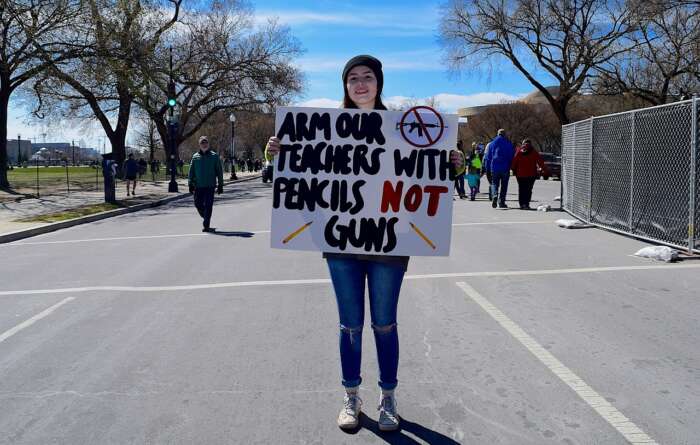As America marked the solemn 25-year anniversary of the Columbine school shooting, our nation continues to grapple with the scourge of gun violence. Rampant gun violence has become the new norm in America.
Many governmental and nonprofit organizations continue to desire to curb this trend by proposing reductions in easy access to lethal weaponry, more long-term investment in social outreach programs, and harsher sentencing to help prevent violence and senseless tragedies.
Cycle of Gun Violence
Despite concerted efforts, the cycle of gun violence persists. Currently there is wide bipartisan support among Americans for gun violence prevention policies, even among gun owners, according to researchers at the Johns Hopkins Center for Gun Violence Solutions.
One innovative, preventive approach for reducing the societal stress and tensions that lead to violence is the widespread implementation of the Transcendental Meditation (TM) program.
Extensive research shows that collective practice of the TM technique and its advanced practices by large groups in unison twice a day creates a field effect that promotes calm and orderliness in the vicinity of the group, diffusing the stresses and tensions that cause societal problems.
Supported by extensive peer-reviewed research spanning psychology, sociology, philosophy, and consciousness studies, the TM program offers a demonstrable antidote to the violence plaguing American society.

Energy and Peace
It is generally accepted that TM practice increases energy and inner peace on the individual level; extensive peer-reviewed studies indicate that it also produces similar effects for society.
The book An Antidote to Violence: Evaluating the Evidence examines 20 peer-reviewed studies which indicate that governments can achieve a lessening of violence in their countries, not on the basis of political rhetoric or a stronger police presence but by a rise of harmony, coherence, and order in the collective consciousness of the people who make up the society.
Study Parameters
Early TM studies show that the larger the number of people practicing the TM technique, the greater the rate of decrease in crime. A follow-up study published in 1981 took new factors into account: population density, median time of education, percentage of people in the same home after five years, and per capita income.
All the crime data were taken from public sources. The results of the research supported the initial hypothesis: a comparatively small number of people practicing TM could reduce crime rates in a given area.
Over the years, other peer-reviewed studies have noted repeated indications that the collective consciousness of a society or a nation is a real phenomenon.
Recent research on large groups practicing TM and its advanced practices together has demonstrated a positive, measurable effect on reducing stress in the collective consciousness of America.
Four Studies
A series of four studies, published in 2016 and 2017, charted reductions in US crime and fatality rates between 2007 and 2010. This was a time of economic hardship for the entire nation, as a result of the sub-prime mortgage collapse-and financial hardship is expected to be positively correlated with crime.
However, during this same time period, an unprecedented number of advanced TM practitioners were engaged in large group TM practice on the campus of Maharishi International University in Fairfield, Iowa.
Results
Research demonstrated an across-the-board drop in crime at a time when typical factors would have predicted rising crime, and criminologists were unable to explain this outcome.
The data correlating large group TM practice with reduced crime strongly suggest that the reductions were attributable to TM advanced group practices. During the experimental period of these US studies, rates of homicides and violent crimes, including aggravated assault, robbery and rape, all decreased compared to the baseline period.
A follow-up study provides evidence that after the group diminished in size in 2011, violent social trends again resumed. This outcome indicates that the improvements only took place and had a lasting effect when the group was of a sufficient size and engaged in group practice consistently on a daily basis.

Factors At Play
The TM antidote to violence weaves together psychology, sociology, philosophy, statistics, politics, physics, and consciousness to provide evidence that we can reduce violence in society.
When TM programs are properly implemented – in schools, the police force, the military, or any place where people gather in a group – the resulting transformation of the collective consciousness of society has significant consequences for the community and its environment.
Through this practical, field-tested approach, the current norm of horrific gun violence could become a thing of the past.
As we reflect on the tragedy of Columbine and its enduring legacy, exploring innovative approaches like TM may hold the key to forging a path toward a safer, more harmonious future.
About the Authors
Arlene Schar is Director of Communications at the Center for Advanced Military Science (CAMS), Institute of Science, Technology & Public Policy (ISTPP) at Maharishi International University (MIU).
Dr. David Leffler served as an Associate of the Proteus Management Group at the Center for Strategic Leadership, US Army War College. Currently, he serves as the Executive Director at CAMS.
Sources
Journal of Crime and Justice, 4, 25-45
Journal of Health and Environmental Research, 3(3-1), 32-43
Journal of Consciousness Studies, 24(1-2), 53 – 86

